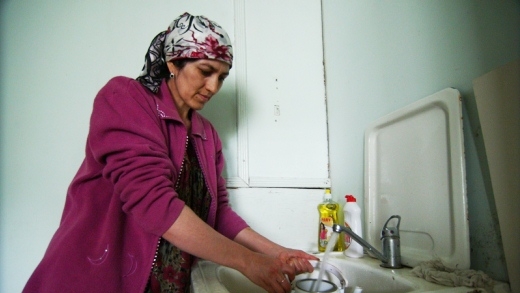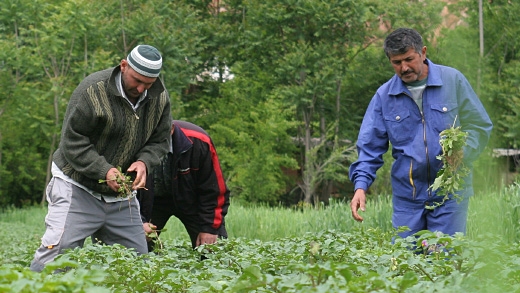Bank Group Contribution
As of April 2014, the portfolio comprises 13 active projects for a total of US$222 million. The largest share of the portfolio is in agriculture and rural development (34 percent), followed by water (19 percent), energy (16 percent), the public sector and economic policy (10 percent), education (8 percent), health and social protection (8 percent), and the private sector (5 percent). Tajikistan’s Trust Fund (TF) portfolio—one of the largest in ECA—is a critical complement to International Development Association (IDA) resources, accounting for about 30 percent of total combined commitments during 2010–13.
To date in FY14, the World Bank has approved two grants—the Health Results-Based Financing Project and the Global Partnership for Education-4 Project—with a total commitment of US$32 million.
The portfolio includes 45 active trust-funded operations with US$63 million in commitments. In addition, Tajikistan is the beneficiary of two new large TFs: one that addresses climate change (Pilot Program for Climate Resilience), with the World Bank share at US$16 million, and another for food security (Global Agriculture and Food Security Program) at US$27.9 million. TF activities cofinance ongoing IDA operations in health, education, agriculture, food security, migration, state procurement, and demand-side governance. The International Finance Corporation (IFC), with its focus on private sector development, has an important role to play in supporting inclusive growth and job creation in Tajikistan. IFC works with private sector clients, government, and civil society to bring global expertise to Tajikistan through its advisory services and investment projects. IFC looks forward to continuing to support reforms to strengthen the investment climate and to increase its direct financing of Tajikistan’s private sector companies.
Since 1997, IFC has invested US$86.9 million to support private sector projects in the financial, hydropower, retail, tourism, and manufacturing sectors. As of December 31, 2013, IFC’s committed portfolio stood at US$28.7 million, which includes investments in financial markets and the agribusiness sector.
IFC’s program in the country includes annual advisory services assistance spending of approximately US$3 million focused on: legal and regulatory infrastructure for SMEs, credit bureau development, corporate governance, tax administration, agricultural finance, and infrastructure advisory. IFC’s advisory services projects are being implemented with financing from the Department for International Development of the United Kingdom (DfID), the Swiss State Secretariat for Economic Affairs (SECO), and the Austrian Development Bank.
Partners
The Tajikistan Development Coordination Council, which brings together 28 development partners and is currently chaired by the World Bank, has played a key role in strengthening country ownership and mutual accountability through sector and thematic working groups, in line with the 2005 Paris Declaration on Aid Effectiveness. At the 2012 Development Forum, development partners (bilateral and multilateral agencies, donors, UN agencies, international financial organizations [IFIs]) agreed upon a number of joint initiatives designed to achieve measurable results by 2015 in line with the Government’s ongoing medium-term Living Standards Improvement Strategy, 2013–15. The initiatives aim to improve the living standards of the population by: a) improving the quality of and access to education, health care, and safe drinking water; b) planning and preparing for economic and climatic shocks, including by increased fiscal savings; c) using scarce public resources wisely and increasing the transparency of public financial management; and d) enlarging the role of the private sector in the economy so as to create jobs, increase the incomes of vulnerable and middle-class groups, and raise revenues for the budget. A multi-partner–financed Communal Services Fund initiated by the World Bank is under preparation for approval in 2015.
Moving Forward
The World Bank Group’s CPS for FY10–13, extended to FY14, will formally end in June 2014. Its principal objective is to help stimulate private investment through overall private sector development. Other key priorities include: (a) ensuring macroeconomic stability and sound public financial management; (b) increasing productivity in agriculture and efficiency in water use; (c) strengthening the power sector for reliable domestic supply and larger hydropower exports; and (d) increasing access to higher quality social services. Improving core governance is being mainstreamed in the context of the Country Governance and Anti-Corruption (CGAC) strategy.
A new CPF for FY15–18 is currently under preparation and is expected to be presented to the Board of Directors in June 2014. Building on the outcomes and lessons learned from the current CPS, the new strategy’s principal goal is to promote shared prosperity by supporting the expansion of opportunities in three areas and related pillars: (a) private sector–led growth; (b) social inclusion; and (c) regional connectivity. The design and implementation of CPS activities under each of these pillars will also be shaped by applying three cross-cutting themes, namely: gender, governance, and climate change.





